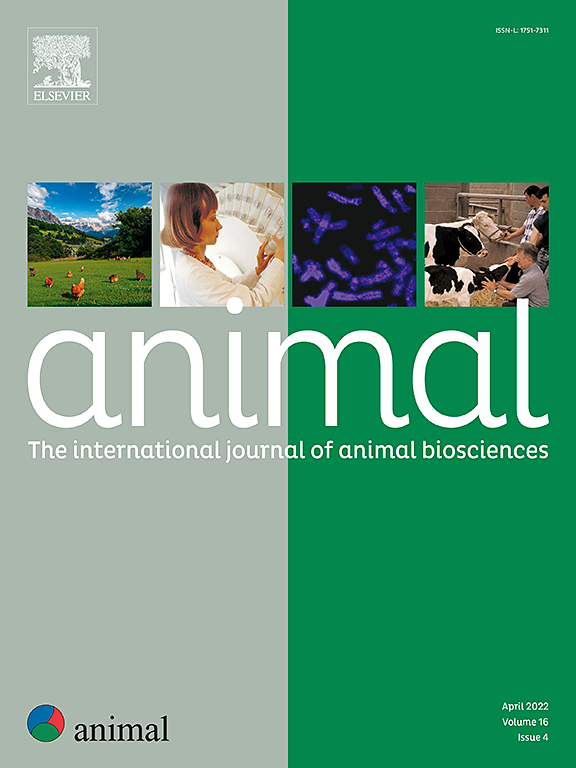利用血浆生物标志物开发和验证肉牛剩余采食量早期预测模型
IF 4
2区 农林科学
Q1 AGRICULTURE, DAIRY & ANIMAL SCIENCE
引用次数: 0
摘要
鉴定生长肉牛饲料效率的血浆生物标志物为开发预测模型以改进精准饲喂策略提供了一个大有可为的机会。然而,这些模型必须准确预测肥育早期阶段的饲料效率。我们的研究旨在评估先前在后期育肥牛中发现的候选生物标志物在早期育肥阶段进行分析的可靠性,并开发特定日粮的剩余采食量(RFI)预测方程。我们从七个队列的 364 头夏洛莱公牛中挑选了 64 头 RFI 值极高的动物。这些动物饲喂玉米或青草饲料。这些动物是从现有的七个群组中的四个群组中挑选出来的。来自三个群组的动物(24 头高 RFI 动物和 24 头低 RFI 动物,平均 RFI 差值为 1.48 千克/天)被用于生物标记物确认和预测模型训练。第四组动物(8 个高 RFI 和 8 个低 RFI,平均 RFI 差值为 0.98 kg/d)用于模型外部验证。在饲料效率测试开始时(333 ± 20 天)采集血样,并对血浆中的 630 种代谢物、15N 自然丰度(δ15N)、胰岛素和 IGF-1 进行定向代谢组学分析。在早期育肥阶段进行分析时,先前确定的七种肉牛后期育肥期RFI血浆生物标志物仍具有区分低RFI和高RFI动物的能力(P <0.05)。在这些已确认的生物标志物中,有五个是草饲动物和玉米饲动物共有的(肌酐、β-丙氨酸、甘油三酯 TG18:0_34:2、对称二甲基精氨酸和磷脂酰胆碱 PC aa C30:2),而有两个是日粮特异性的(青贮草料日粮中的 IGF-1 和青贮玉米日粮中的异亮氨酸)。在早期育肥阶段,没有发现新的 RFI 血浆生物标志物(假发现率为 0.05)。根据早期育肥阶段分析的七种已确认的 RFI 生物标志物建立了预测模型。两个逻辑回归模型包含肌酐和 IGF-1(青贮饲料)或 PC aa C30:2(玉米青贮饲料),能有效区分高和低 RFI 动物,灵敏度和特异性都很高(曲线下面积为 0.80)。模型中使用的生物标志物在育肥早期和后期表现出中等到较高的重复性(0.45 < r < 0.65)。这些模型成功通过了外部验证,第四批动物中有 85% 以上被正确分类。一旦在更大的群组中得到验证,并利用具有成本效益的快速分析方法,这些模型可支持精准饲养和育种计划,从而降低肉牛饲养成本。本文章由计算机程序翻译,如有差异,请以英文原文为准。
Development and validation of a model for early prediction of residual feed intake in beef cattle using plasma biomarkers
Identification of plasma biomarkers for feed efficiency in growing beef cattle offers a promising opportunity for developing prediction models to improve precision feeding strategies. However, these models must accurately predict feed efficiency at early stages of fattening. Our study aimed to evaluate the reliability of candidate biomarkers previously identified in late-fattening cattle when analysed during early fattening stages and to develop diet-specific prediction equations for residual feed intake (RFI). From a total of 364 Charolais bulls across seven cohorts, we selected 64 animals with extreme RFI values. The animals were fed either a corn‑ or grass-silage diets. These animals were chosen from four out of the available seven cohorts. Animals from three cohorts (24 high-RFI and 24 low-RFI, having a mean RFI difference of 1.48 kg/d) were used for biomarker confirmation and prediction model training. Animals from a fourth cohort (8 high-RFI and 8 low-RFI, having a mean RFI difference of 0.98 kg/d) were used for model external validation. Blood samples were collected at the beginning of the feed efficiency test (333 ± 20 days), and plasma underwent targeted metabolomic for 630 metabolites, natural abundance of 15N (δ15N), insulin, and IGF-1 analysis. Seven previously identified plasma biomarkers for RFI in late-fattening beef cattle still kept their capability for discriminating low and high RFI animals when analysed during early fattening stages (P < 0.05). Among these confirmed biomarkers, five were common for both grass- and corn-fed animals (creatinine, β-alanine, triglyceride TG18:0_34:2, symmetric dimethyl-arginine and phosphatidylcholine PC aa C30:2) while two were diet-specific (IGF-1 for grass silage-based diet, and isoleucine for corn silage-based diet. No new plasma biomarkers of RFI were identified at early-fattening stages (false discovery rate > 0.05). Prediction models were developed based on seven confirmed RFI biomarkers analysed during early-fattening. Two logistic regression models incorporating creatinine and either IGF-1 (for grass silage-based diet) or PC aa C30:2 (for corn silage-based diet) effectively distinguished between high− and low-RFI animals with high sensitivity and specificity (area under the curve > 0.80). The biomarkers used in the models showed moderate to high repeatability between early and late fattening stages (0.45 < r < 0.65). The models were successfully externally validated, with more than 85% of animals from the fourth cohort correctly classified. Once validated in larger cohorts and utilising cost-effective and rapid analytical methods, these models could support precision feeding and breeding programmes, aiming to reduce the cost of raising beef cattle.
求助全文
通过发布文献求助,成功后即可免费获取论文全文。
去求助
来源期刊

Animal
农林科学-奶制品与动物科学
CiteScore
7.50
自引率
2.80%
发文量
246
审稿时长
3 months
期刊介绍:
Editorial board
animal attracts the best research in animal biology and animal systems from across the spectrum of the agricultural, biomedical, and environmental sciences. It is the central element in an exciting collaboration between the British Society of Animal Science (BSAS), Institut National de la Recherche Agronomique (INRA) and the European Federation of Animal Science (EAAP) and represents a merging of three scientific journals: Animal Science; Animal Research; Reproduction, Nutrition, Development. animal publishes original cutting-edge research, ''hot'' topics and horizon-scanning reviews on animal-related aspects of the life sciences at the molecular, cellular, organ, whole animal and production system levels. The main subject areas include: breeding and genetics; nutrition; physiology and functional biology of systems; behaviour, health and welfare; farming systems, environmental impact and climate change; product quality, human health and well-being. Animal models and papers dealing with the integration of research between these topics and their impact on the environment and people are particularly welcome.
 求助内容:
求助内容: 应助结果提醒方式:
应助结果提醒方式:


